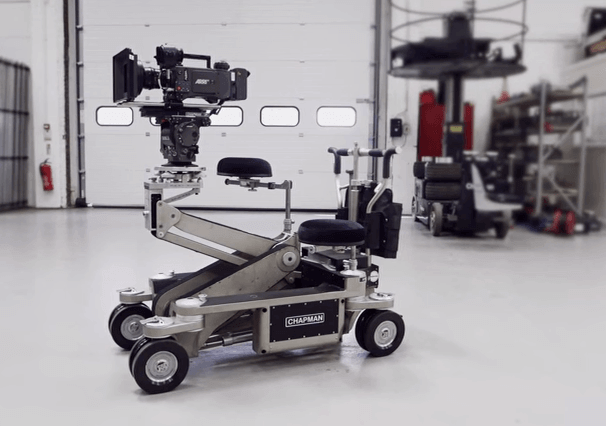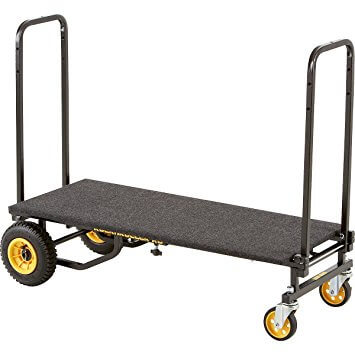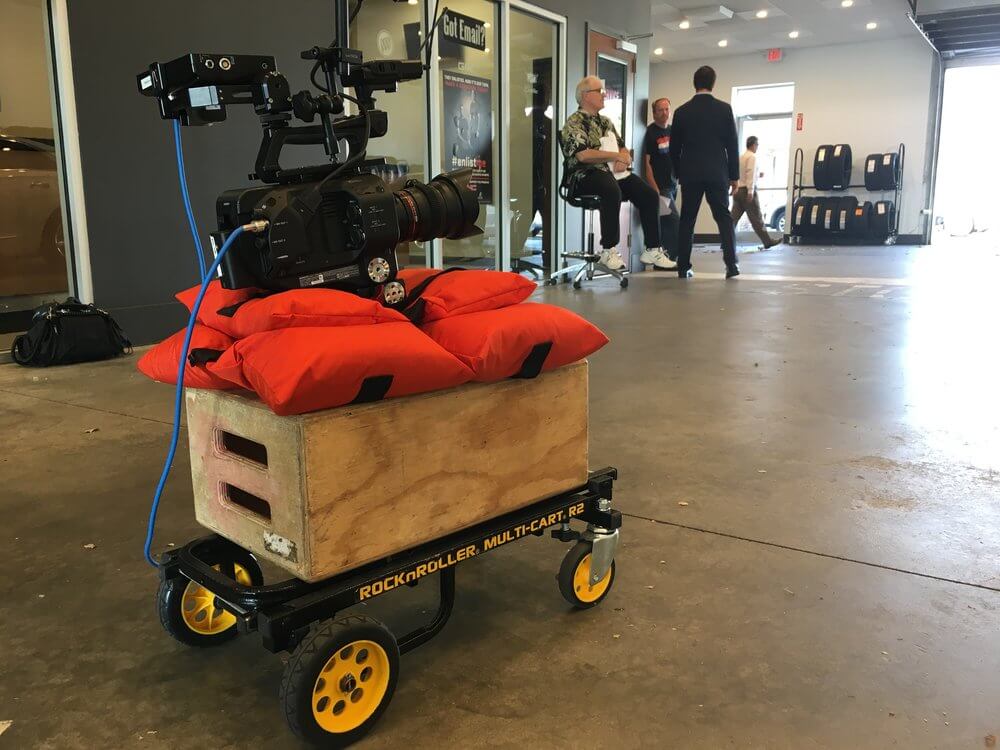How To Build A Dolly For Your Camera At Home
DIY: How to Build a Photographic camera Dolly
For those of yous new to a filmmaking, the showtime question is: what is a camera dolly? Quoting from Wikipedia:
"A photographic camera dolly is a wheeled cart or similar device used in filmmaking and film/television production to create polish camera moments"
A dolly is a staple slice of equipment for many professional and indie films alike. Information technology ordinarily consists of a track ranging from a length of ten feet to 50 feet and sometimes even further. Professional tracks are generally fabricated of aluminum and other low-cal metals (whereas most DIY tracks are made out of PVC).
Dollies are used quite frequently in films because they allow polish movement of the photographic camera to follow activeness and to create tension or add depth. With a dolly you lot tin can go forward, backward, side-to-side, and even diagonal. And with the correct kind of tracking/cycle combination, yous tin can fifty-fifty go in circles and large curves.
Information technology can be a motorized photographic camera dolly or it can be operated by a camera operator and a focus puller to push the dolly dorsum and forth.

As a filmmaker, you must constantly figure out ways to meliorate the product value of your projects, and a camera dolly is a valuable piece of equipment to do just that. Let's examine the four ways a dolly can make impact your film project:
- Tracking shots – When a dolly is used, it'south like a camera on tracks. It mimics the movement of the subject in frame. For instance, it can go sideways from left to right to track the movement of actors. The camera creates a dynamic move to go along the audience interested in the scene. Instead of having static actors talking at each other, why not accept them moving left to right with the a dolly to rail their movement equally they speak? It's much more interesting.
- Pushing in and out– Instead of using the camera to zoom in and out with the lens, you can put a portable dolly on tracks and the entire piece of equipment zooms in and out, commonly on tracks. This movement highlights the importance of a detail character and what he or she has to say at that moment in time.
- Moving up and down– Usually, this movement can be done with a camera jib. Merely there are dollies that tin can perform this function, such as products made by JL Fisher and Chapman.
Here's an case of an Epic tracking shot fromSpectre:
WHEN YOU HAVE BILLIONS OF DOLLARS, YOU TOO Tin MAKE THIS AMAZING TRACKING SHOT.
For most beginner filmmakers, purchasing a dolly is usually not an option. Not but does it toll money, but you really demand to know what y'all're doing or you could terminate up damaging your photographic camera. There is the possibility to rent out a dolly from a reputable vendor. Some places you lot can effort:
- Kitsplit
- B&H
Dollies make a large difference in whatever picture show project, and are very very useful. However, to buy a professionally-made dolly from a vendor, you can spend hundreds of dollars for just a decent one. Almost indie filmmakers can't beget that kind of dough, so instead they make their own. And that'southward exactly what I did; I made my very ain camera dolly!
Here's what I did to create a portable, lightweight dolly:
I took 1 of those studio dollies, the kind with the crappy rubber wheels and the 3-prong blueprint. They're mostly used by photographers in studios to movement around a tripod easily. The heavy-duty kind are used in Idiot box studios to movement around those behemothic television receiver cameras. The one I used is ane of the cheaper kinds you lot tin can get off Ebay and other discount stores.
The first important thing nigh DIY dollies are the mode the wheels are mounted. To use them effectively, they should be mounted at an angle to help stay on the track. The employ of angle iron allows a mountable surface just perfect for making the wheels angled.
And then I bought some bending fe with pre-drilled holes in it (how convenient) which you can get at your typical hardware shop. Luckily the bolts from the studio dolly were simply the right size to fit through the holes drilled into the atomic number 26, so all I had to practise was spiral in the angled atomic number 26 where the wheels used to go. I actually got off easy there. In most other cases you'll have to drill through some metal to mount the iron to whatever you're using, and so exist conscientious.
To aide with the mounting of the wheels, I bought some washers, bolts, and nuts. They were all 3/eight″ size, merely the sizes might be different according to invididual circumstances. I also got some nylon spacers to space the wheels away from the angled fe. Once again, all of these parts tin can be found at a hardware store. Nothing obscure, I promise.
The 2d important matter about dollies are the wheels themselves. I've seen people use skateboard wheels, roller skate wheels, and let's not forget rollerblade wheels. To exist frank, information technology doesn't matter what is used, every bit long as the wheels come with bearings. Without bearings the wheels will grab and hang on the bolts used to attach them to the angled iron. With bearings, the rolling is smooth. I recommend using rollerblade wheels and nothing else. I bought a set of viii for $35 at a run-of-the-manufactory sports shop.
The third important thing near dollies is the placement of the wheels. Certainly you can put them directly across from each other and it'll work, merely many people recommend to stagger them. You'll come across what staggering ways by looking at the pictures beneath. The main reason you should stagger is considering the weight of the dolly will be more evenly spread throughout the base of operations of the dolly. If y'all come up beyond a bump in the rails, it won't be every bit noticeable, if at all.
To mount the wheels, I used an "intricate" blueprint I cooked up in this club: (from the outside to the within) Bolt, wheel, nylon spacer, washer, angle iron, washer, nut.
Tighten the nut equally far as you can, and it should stay firmly in place. Yous may need to loosen the nut a bit if you tighten it likewise far, to brand certain the wheel turns properly.
In my design I only used eight wheels; ii on each prong and an extra two on the lone prong. I've seen designs use only as much, but I've too seen some utilise 12 or sixteen.
Virtually other designs will need to create their own notches to hold the tripod legs. This blueprint really saved some work, merely I recognize non everyone has a studio dolly lying around. What's absurd near the holders is that they're adjustable, too. However the downside is that they won't extent to their full length, due to the wheels obstructing the path.
Too notation the track, which is fabricated out of ane″ PVC piping and connected with 3/4″ PVC jammed in-betwixt them. I bought them in 5′ lengths, which makes them easier to store and transport. Of course, you could purchase 10 foot lengths at a cheaper price and cut them yourself, only where's the fun in that?
On the ends of the track I cut some actress PVC and used elbow joints to create a buffer at the end. This keeps the tracks together in case they're on a slight incline, or if someone is a fleck careless with their extremities.
A Really Cheap Way to Build a Portable Dolly
In a higher place explains a very easily-on approach to create an affordable and collapsible dolly. However, I exercise admit that it involves a lot of handyman work. Here is a simple one nosotros created for a recent TV airplane pilot shoot.
Substantially, we took a used a Stone N Roller Multicart and put a sturdy box on height of it.

Then nosotros placed a agglomeration of film sandbags on meridian of it. Finally, nosotros rested our Sony FS7 correct on elevation. The finished product looks like this:

This contraction worked very well on our push-in shots, every bit the camera on wheels acted similar they were camera on tracks. The cart provided enough stability to create an astonishing shot of the scene. When you're looking at this contraption, you might be thinking information technology's only good for push-ins. However, it can likewise work for side-to-side motility.
We didn't employ it for side-to-side motion in this shoot. But you should take hands turned the camera sideways and had the camera operator push the cart from left to right or right to left.
One thing of note. It is suggested that yous have at least ii people operating this contraction. Ane person will actually push the camera. The other person will work to stabilize it. The final thing yous need is for the camera to fall on the footing and cost you $10K to replace it.
This setup will only cost y'all the cart, a box and the sand bags. Nonetheless, whatsoever serious filmmaker will already take these tools and then this setup can easily piece of work for someone with the basic tools.
What if You're Really, Really on Budget
Beginning, I presume you'll have a camera – whether information technology's a Sony FS7 or a RED. But let'due south say you lot don't even take a picture palace photographic camera and all you had was an iPhone. It'south still easy to create a "dolly." You might not be able to afford a motorized camera dolly or you might not have the funds to rent 1. Simply all you actually need is anything with wheels.
Yous can stand up on a skateboard with your iPhone and have your friend push or tug you along. You lot tin exist on rollers skates and accept someone push button y'all toward the actors for a classic push-in shot.
Point is you just need to have an imagination to create an affordable camera dolly. Not everybody started with a RED Camera and a fancy Hollywood dolly like a Chapman motorized dolly.
You can easily create a lightweight, affordable camera dolly with an iPhone, ii friends and a skateboard.
This is what it means to be an indie filmmaker. You piece of work within your budget. You focus on story and strong characters. And yous make the about of what you lot have.
A camera dolly is a nifty fashion to improve the production value of your flick projects. Hopefully, these tips on creating an affordable dolly volition become you lot going on your film project. Good luck!
Source: https://www.2bridges.nyc/filmmaking-guide/diy-how-to-build-a-camera-dolly/
Posted by: nelsoncovelf.blogspot.com

0 Response to "How To Build A Dolly For Your Camera At Home"
Post a Comment